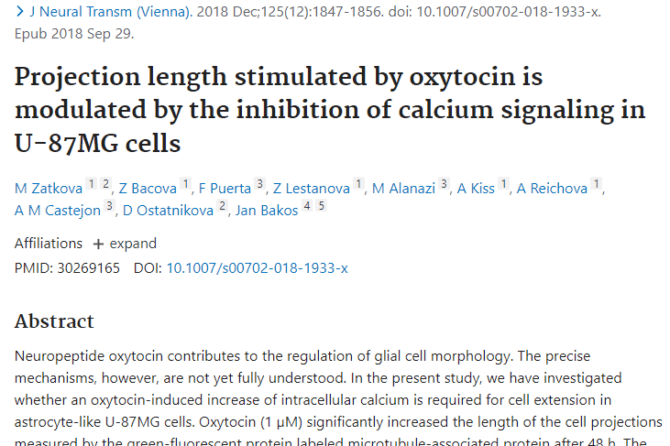
AUTORI: Zatkova, M., Z. Bacova, F. Puerta, Z. Lestanova, M. Alanazi, A. Kiss, A. Reichova, A.M. Castejon, D. Ostatnikova, and J. Bakos
ABSTRACT: Neuropeptide oxytocin contributes to the regulation of glial cell morphology. The precise mechanisms, however, are not yet fully understood. In the present study, we have investigated whether an oxytocin-induced increase of intracellular calcium is required for cell extension in astrocyte-like U-87MG cells. Oxytocin (1 µM) significantly increased the length of the cell projections measured by the green-fluorescent protein labeled microtubule-associated protein after 48 h. The knockdown of oxytocin receptors (OXTR) in U-87MG cells prevented the elongation of the projections. Incubation of U-87MG cells in the presence of oxytocin, resulted in a significant increase of intracellular calcium, specifically blocked by the OXTR antagonist L-371,257. Both quercetin, which is a phosphoinositide 3-kinase inhibitor, and the phospholipase C inhibitor U-73122 reduced oxytocin-induced elevation of intracellular calcium concentration. Conversely, neither diltiazem, an L-type voltage-gated calcium channel blocker nor tetracaine, which is a blocker of the ryanodine receptors, showed an effect on intracellular calcium levels. Treatment of cells with quercetin, U-73122 and the voltage-gated calcium channel blockers cilnidipine, ω-agatoxin and mibefradil prevented the elongation of projections stimulated by oxytocin. Oxytocin treatment resulted in a significant increase in gene and protein expression of the scaffolding protein SHANK3. Our results clearly show that activation of OXTRs contributes to the elongation of cell projections in astrocyte-like U-87MG cells and that this effect is mediated by an extracellular calcium influx accompanied by an increase in scaffolding proteins expression.
J Neural Transm (Vienna), 2018. 125(12): p. 1847-1856.


